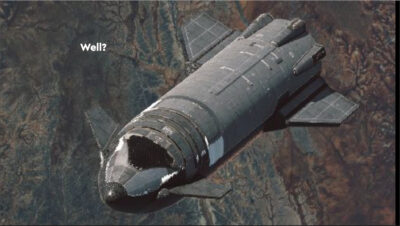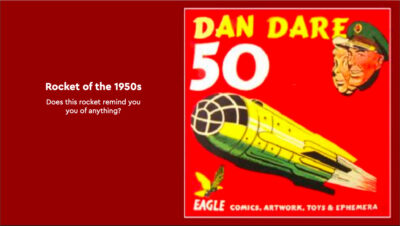The talk to members at our June 2024 meeting of the Orpington Astronomical Society was given by Greg Smye-Rumsby our President. His talk titled Game Changers covered a personal view of key events in the astronomical world. Note: Greg very kindly stepped in to replace our original speaker Keith Brackenborough who wasn’t able to give his talk due to an accident.
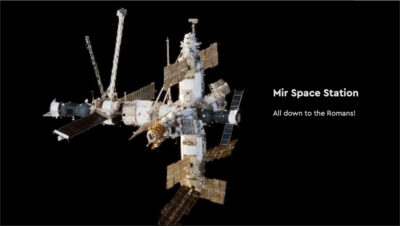 Greg, who has spent 20 years at the Royal Observatory Greenwich started his talk by stating that the MIR Space Station was all down to the Romans! Chariot axle widths were used as the basis of track gauges for railways which meant the size of MIR components were influenced by what could be transported on the USSR rail system.
Greg, who has spent 20 years at the Royal Observatory Greenwich started his talk by stating that the MIR Space Station was all down to the Romans! Chariot axle widths were used as the basis of track gauges for railways which meant the size of MIR components were influenced by what could be transported on the USSR rail system.
Greg then highlighted the key people and key historical events that had influenced the way astronomical thinking had developed over the centuries. Early in this process was Heraclides Ponticus (c.390-310 BC) who proposed that the Earth is a spherical world and spins on its axis taking one day to do so. Glasses were invented in the 1200s, but it wasn’t until around 400 years later that the first telescopes were developed.
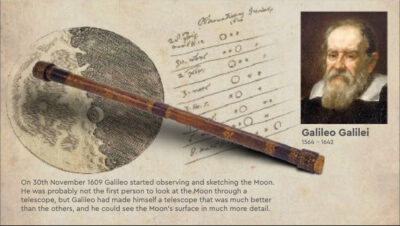 In 1609 Galileo started observing the Moon through a telescope. He probably wasn’t the first person to do so, but his telescope was better than the others and he could see the Moon’s surface in much more detail. However, it wasn’t until Johannes Kepler developed his laws of planetary motion that our solar system became more widely understood and the Copernican model of the Sun-centred Universe was more widely accepted.
In 1609 Galileo started observing the Moon through a telescope. He probably wasn’t the first person to do so, but his telescope was better than the others and he could see the Moon’s surface in much more detail. However, it wasn’t until Johannes Kepler developed his laws of planetary motion that our solar system became more widely understood and the Copernican model of the Sun-centred Universe was more widely accepted.
Greg pointed out that Sir Isaac Newton was recognised as one of the greatest mathematicians and physicists of all time and his development of the principles of modern science, including the laws of motion, meant he was a key figure in the science revolution of the 17th century.
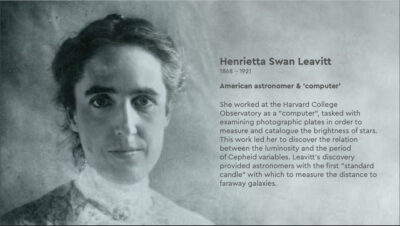 With more and more research being undertaken it was in the late 1800s that a group of skilled women (The ‘Computers’) began processing astronomical data. Two of these women Annie Jump Cannon and Henrietta Swan Leavitt changed the face of science. Henrietta discovered the relationship between the luminosity and the period of Cepheid variables which provided astronomers with the means to measure the distance to faraway galaxies.
With more and more research being undertaken it was in the late 1800s that a group of skilled women (The ‘Computers’) began processing astronomical data. Two of these women Annie Jump Cannon and Henrietta Swan Leavitt changed the face of science. Henrietta discovered the relationship between the luminosity and the period of Cepheid variables which provided astronomers with the means to measure the distance to faraway galaxies.
The talk moved on to perhaps the most significant achievement in space exploration – the first moon landing, but it was noted that despite the BBC having started to broadcast in colour in 1967 the pictures sent back from the moon on 21st July 1969 were in black and white. Other notable missions were mentioned, highlighting their significance in exploring the planets in our solar system and the technical challenges they faced.
 Greg mentioned some of his own personal experiences over the the course of his career. One of which was to build an 18” reflector telescope for the OAS in the grounds of Newstead Wood School in Orpington. The foundations were started, but the project was subsequently abandoned as flood lights were installed in the school’s playing fields.
Greg mentioned some of his own personal experiences over the the course of his career. One of which was to build an 18” reflector telescope for the OAS in the grounds of Newstead Wood School in Orpington. The foundations were started, but the project was subsequently abandoned as flood lights were installed in the school’s playing fields.
The final section of the talk related to more recent achievements including the first image of a black hole and the latest developments in rocket designs, particularly the SpaceX Starship which Greg pointed out had some similarities with a Dan Dare rocket that featured in 1950’s Eagle comics.
This was a very entertaining and thought provoking talk which Greg delivered with great enthusiasm and it was made all the more interesting by the incorporation of some of his own experiences.
Prepared by Jim Worthington


